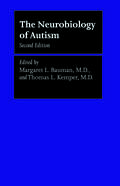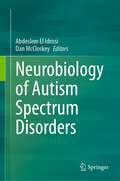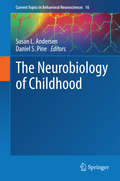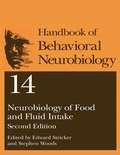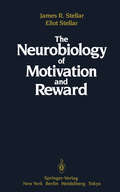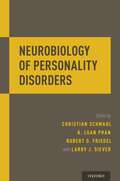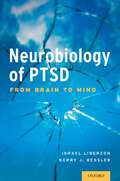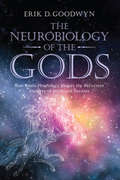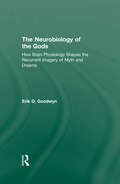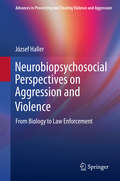- Table View
- List View
The Neurobiology of Autism (The Johns Hopkins Series in Psychiatry and Neuroscience)
by Margaret L. BaumanIn the decade since the first edition of The Neurobiology of Autism was published, research has revealed valuable new information about the nature and origins of autism, including genetics and abnormalities in such neurotransmitters as acetylcholine and serotonin. For this long-anticipated new edition, neurologists Margaret L. Bauman and Thomas L. Kemper bring together leading researchers and clinicians to present the most current scientific knowledge and theories about autism. The contributors cover genetics, imaging studies, physiology, neuroanatomy and neurochemistry, immunology, brain function, the epidemiology of the disease, and related disorders. Thoroughly updated, The Neurobiology of Autism remains the best single-volume work on the wide array of research being conducted into the causes, characteristics, and treatment of autism.Contributors: George M. Anderson, Yale Child Study Center; Tara L. Arndt, University of Rochester Medical Center (URMC); Trang Au, University of Massachusetts Medical School (UMMC); Jocelyne Bachevalier, University of Texas Health Science Center; Irina N. Bespalova, Seaver Autism Research Center, Mt. Sinai School of Medicine (SARC); Gene J. Blatt, Boston University School of Medicine (BUSM); Susan E. Bryson, IWK Health Centre–Dalhousie University; Timothy M. Buie, Massachusetts General Hospital (MGH); Joseph D. Buxbaum, SARC; Kathryn M. Carbone, The Johns Hopkins University School of Medicine (JHUSM); Diane C. Chugani, Wayne State University; Daniel F. Connor, UMMC; Edwin H. Cook, Jr., University of Chicago; S. Hossein Fatemi, University of Minnesota Medical School; Susan E. Folstein, Tufts University School of Medicine; Eric Fombonne, McGill University; Randi Jenssen Hagerman, UC Davis Medical Center; Elizabeth Petri Henske, Fox Chase Cancer Center, Philadelphia; Jeannette J. A. Holden, Queen's University; Ronald J. Killiany, BUSM; Omanand Koul, UMMC; Mandy Lee, Newcastle General Hospital, U.K.; Xudong Liu, Queen's University; Tara L. Moore, BUSM; Mark B. Moss, BUSM; Karin B. Nelson, National Institute of Neurological Disorders and Stroke; Phillip G. Nelson, National Institute of Child Health and Human Development; Elaine Perry, Newcastle General Hospital; Jonathan Pevsner, JHUSM; Mikhail V. Pletnikov, JHUSM; Stephen W. Porges, University of Illinois at Chicago; Lucio Rehbein, Universidad de la Frontera, Chile; Jennifer Reichert, SARC; Patricia M. Rodier, URMC; Beth Rosen-Sheidley, MGH; Susan L. Smalley, UCLA Neuropsychiatric Research Institute; Ronald J. Steingard, UMMC; Helen Tager-Flusberg, BUSM; Gary L. Wenk, University of Arizona; Andrew W. Zimmerman, JHUSM
Neurobiology of Autism Spectrum Disorders
by Abdeslem El Idrissi Dan McCloskeyThis book brings together the exciting new findings that will bring us closer to a better understanding of the alterations of neuronal connectivity in autistic brains. This volume authoritatively covers the epidemiology, physiology, neurodevelopment, genetics, environmental influences, imaging studies, neuroanatomy, and neurochemistry of autism spectrum disorders. While the neurobiology of autism is still a long way from being understood, this book posits techniques, such as using brain imaging to find signatures in early days of life, that could help move the diagnosis and help identify neural pathways. Understanding these mechanisms opens the possibility to pharmacological, behavioral, and psychosocial therapeutic interventions. With contributions from the leading international autism researchers, Neurobiology of Autism Spectrum Disorders is the go-to reference for researchers and clinicians with an interest in understanding the underlying neurobiology of autism spectrum disorders.
The Neurobiology of Brain and Behavioral Development
by Robbin Gibb Bryan KolbThe Neurobiology of Brain and Behavioral Development provides an overview of the process of brain development, including recent discoveries on how the brain develops. This book collates and integrates these findings, weaving the latest information with core information on the neurobiology of brain development. It focuses on cortical development, but also features discussions on how the other parts of the brain wire into the developing cerebral cortex. A systems approach is used to describe the anatomical underpinnings of behavioral development, connecting anatomical and molecular features of brain development with behavioral development.The disruptors of typical brain development are discussed in appropriate sections, as is the science of epigenetics that presents a novel and instructive approach on how experiences, both individual and intergenerational, can alter features of brain development. What distinguishes this book from others in the field is its focus on both molecular mechanisms and behavioral outcomes. This body of knowledge contributes to our understanding of the fundamentals of brain plasticity and metaplasticity, both of which are also showcased in this book. - Provides an up-to-date overview of the process of brain development that is suitable for use as a university textbook at an early graduate or senior undergraduate level - Breadth from molecular level (Chapters 5-7) to the behavioral/cognitive level (Chapters 8-12), beginning with Chapters 1-4 providing a historical context of the ideas - Integrates the neurobiology of brain development and behavior, promoting the idea that animal models inform human development - Presents an emphasis on the role of epigenetics and brain plasticity in brain development and behavior
Neurobiology of Central D1-Dopamine Receptors (Advances in Experimental Medicine and Biology #204)
by George BreeseOur understanding of the functional mechanisms relating dopamine activity to normal and abnormal behavior has been turned "upside-down" by the recent developments described in the chapters of this volume. Heretofore, it was generally agreed that all of the pharmacological and behavioral properties ascribed to dopamine systems were mediated via activation or inhibition of the subtype of dopamine receptors termed D2. The properties of these receptors were first characterized in 1975 following their identification by receptor binding techniques utilizing 3H-butyrophenones, potent antipsychotic drugs, used in the treatment of schizophrenia. Although another subtype of dopamine receptor had already been identified a few years earlier, now termed the Dl receptor, its functional properties were unknow- other than the fact that it was associated with the activation of the enzyme adenylate cyclase. Our absence of knowledge of the behavioral functions of this receptor stemmed primarily from the lack of selective agonist and antagonists for DI receptors - drugs which did not also interact with D2 receptors. Selective agents for D2 receptors did exist and hence the behavioral roles of D2 receptors were easily ascribed. The work described in this text is primarily stimulated by the development of two selective Dl receptor drugs - the antagonist SCH 23390 and the agonist SKF 38393. The studies described herein clearly show that D1 receptors do indeed have many behavioral functions, on the surface often similar to those responses mediated by D2 receptors.
The Neurobiology of Childhood (Current Topics in Behavioral Neurosciences #16)
by Susan L. Andersen and Daniel S. PineDuring the past years there has been rapid progress in the understanding of how early life stress impacts psychopathology in children. The first two parts of this book present the basic principles of brain development and describe the most important neuronal systems. This includes systems involved in emotion processing, cognitive control, and social processes. These first two general sections are followed by an overview about recent research on various neuronal and psychiatric disorders, where environmental exposures and altered brain development play an important role: sleep, autism, ADHD and other developmental forms of psychopathology.
Neurobiology of Comparative Cognition (Comparative Cognition and Neuroscience Series)
by Raymond P. Kesner David S. OltonThis book represents a unique and elaborate exposition of the neural organization of language, memory, and spatial perception in a wide variety of species including humans, bees, fish, rodents, and monkeys. The editors have united the comparative approach with its emphasis on evolutionary determinants of behavior, the neurobiological approach with its emphasis on the neural determinants of behavior, and the cognitive approach with its emphasis on understanding higher-order mental functions. The combination of these three approaches provides an unusual look at the neurobiology of comparative cognition, and should stimulate increased investigations in this field and related disciplines.
Neurobiology of Comparative Cognition (Comparative Cognition and Neuroscience Series)
by Raymond P. Kesner David S. OltonThis book represents a unique and elaborate exposition of the neural organization of language, memory, and spatial perception in a wide variety of species including humans, bees, fish, rodents, and monkeys. The editors have united the comparative approach with its emphasis on evolutionary determinants of behavior, the neurobiological approach with its emphasis on the neural determinants of behavior, and the cognitive approach with its emphasis on understanding higher-order mental functions. The combination of these three approaches provides an unusual look at the neurobiology of comparative cognition, and should stimulate increased investigations in this field and related disciplines.
The Neurobiology of Criminal Behavior (Neurobiological Foundation of Aberrant Behaviors #5)
by Joseph GlicksohnNeurobiology of Exceptionality (The Springer Series on Human Exceptionality)
by Con StoughNurture or nature? Biology or environment? Why are some people intelligent, or personable, or creative and others obtuse, or shy, or unimaginative? Although each human being is a unique mixture of positive and negative traits and behaviors, the question remains: What is the neurobiological basis for each individual’s makeup? For example, why does one person suffer from a disorder (e.g., ADHD, autism, mental retardation) and another lives free of maladies? These are just some of the issues addressed in detail in Neurobiology of Exceptionality. The introductory chapter provides a broad-based overview of current neurobiological techniques (i.e., terms, procedures, and technologies), which are followed by chapters that offer in-depth examination of the neurobiological bases for: • Impulsive sensation seeking • Creativity • Intelligence • Antisociality • Autism, mental retardation, and Down Syndrome • ADHD • Savant Syndrome This volume provides a one-stop source for clinical psychologists and other allied mental health professionals to access information on a wide range of research on the neurobiology of psychological and psychiatric traits. It is designed to give readers an overview of the current knowledge base of the biological processes for each trait. It is unlikely that any one book could cover all human traits, but the Neurobiology of Exceptionality addresses a wide range of exceptional psychological traits and psychiatric disorders.
Neurobiology of Food and Fluid Intake (Handbooks of Behavioral Neurobiology #14)
by Edward M. Stricker Stephen WoodsLike previous handbooks, the present volume is an authoritative and up-to-date compendium of information and perspective on the neurobiology of ingestive behaviors. It is intended to be stimulating and informative to the practitioner, whether neophyte or senior scholar. It is also intended to be accessible to others who do not investigate the biological bases of food and ?uid ingestion, who may teach aspects of this material or simply wonder about the current state of the ?eld. To all readers, we present this handbook as a progress report, recognizing that the present state of the ?eld is much farther along than it was the last time a handbook was published, but mindful of the likelihood that it is not as far along as it will be when the next handbook is prepared. This ?eld has witnessed a spectacular accretion of scienti?c information since the ?rst handbook was published in 1967. During the generation of science between then and the publication of the second handbook in 1990, numerous scienti?c reports have substantially changed the perspective and informational base of the ?eld.
Neurobiology of Language
by Gregory Hickok Steven L. SmallNeurobiology of Language explores the study of language, a field that has seen tremendous progress in the last two decades. Key to this progress is the accelerating trend toward integration of neurobiological approaches with the more established understanding of language within cognitive psychology, computer science, and linguistics. This volume serves as the definitive reference on the neurobiology of language, bringing these various advances together into a single volume of 100 concise entries. The organization includes sections on the field's major subfields, with each section covering both empirical data and theoretical perspectives. "Foundational" neurobiological coverage is also provided, including neuroanatomy, neurophysiology, genetics, linguistic, and psycholinguistic data, and models. - Foundational reference for the current state of the field of the neurobiology of language - Enables brain and language researchers and students to remain up-to-date in this fast-moving field that crosses many disciplinary and subdisciplinary boundaries - Provides an accessible entry point for other scientists interested in the area, but not actively working in it – e.g., speech therapists, neurologists, and cognitive psychologists - Chapters authored by world leaders in the field – the broadest, most expert coverage available
Neurobiology of Learning and Memory
by Raymond P. Kesner Joe L. Martinez Jr.The first edition of Neurobiology of Learning and Memory was published in 1998 to rave reviews. As before, this second edition will discuss anatomy, development, systems, and models though the organization and content is substantially changed reflecting advances in the field. Including information from both animal and human studies, this book represents an up-to-date review of the most important concepts associated with the basic mechanism that support learning and memory, theoretical developments, use of computational models, and application to real world problems. The emphasis of each chapter will be the presentation of cutting-edge research on the topic, the development of a theoretical perspective, and providing an outline that will aid a student in understanding the most important concepts presented in the chapter.*New material covers basal ganglia, cerebellum, prefrontal cortex, and fear conditioning*Additional information available on applied issues (i.e., degenerative disease, aging, and enhancement of memory)*Each chapter includes an outline to assist student understanding of challenging concepts*Four-color illustrations throughout
Neurobiology of Learning and Memory
by Joe L. Martinez Jr. Raymond P. KesnerNeurobiology of Learning and Memory provides an excellent overview of current information on this fast-growing field of neurobiology. The contents have been structured for use as a course text or as a handy resource for researchers in neuro- and cognitive psychology. It discusses learning and memory from developmental, pharmacological, and psychobiological perspectives, as well as changes in learning and memory with age. Neurobiology of Learning and Memory also includes research on invertebrates and vertebrates, presenting basics in anatomy and development along with computational models. It is written in an easy-to-follow format with summaries at the end of each chapter.Key Features* Provides an overview of information on the neurobiology of learning and memory* Discusses learning and memory from developmental, pharmacological, and psychobiological perspectives, and changes in learning and memory with age* Includes research on invertebrates and vertebrates* Gives basics on anatomy and development* Written for easy comprehension with chapter summaries
The Neurobiology of Learning and Memory
by Jerry W. RudyTo understand how the brain learns and remembers requires an integration of psychological concepts and behavioral methods with mechanisms of synaptic plasticity and systems neuroscience. The Neurobiology of Learning and Memory, Third Edition, provides a synthesis of this interdisciplinary field. Each chapter makes the key concepts transparent and accessible to a reader with minimal background in either neurobiology or psychology and is extensively illustrated with full-color photographs and figures depicting important concepts and experimental data. The goal of this book remains the same as it was for the previous editions-to present a story of how memories are made. The story has three major parts, which have been expanded to include new chapters or reorganized to incorporate new findings and concepts. Part One explores the molecular basis of the synaptic changes that support memory. It begins with an overview of memory from the perspective of the brain. It next describes the long-term potentiation methodology used to study how synapses are modified and concepts needed to understand the organization of synapses. The remaining chapters are organized around the idea that the synaptic changes that support long-term potentiation evolve in four overlapping stages referred to as (a) generation, (b) stabilization, (c) consolidation, and (d) maintenance. The goal of each chapter is to reveal that each stage depends on unique molecular processes and to describe what they are. There are now separate chapters on the generation and stabilization of long-term memory and the chapter Consolidating LTP: Specific Mechanisms has been extensively revised to give proper treatment to the local events in the dendritic spine region that consolidate memories. Part Two builds on this foundation to show how molecules and cellular processes that have been identified from studies of synaptic plasticity also participate in the making of memories. It discusses some of the basic conceptual issues researchers face in trying to relate memory to synaptic molecules and describes some of the behavioral and neurobiological methods that are used. The chapters describing the processes involved in memory formation and consolidation have been extensively modified to provide a more detailed account of the molecular events that are engaged to ensure that established memories endure. The chapter Maintaining Long-Term Potentiation has been revised to provide a broader view of the topic. New chapters focus on recent advances in the neurobiology of forgetting (The Yin and Yang of Memory: Forgetting versus Maintenance) and the search for engrams (Hunting for Engrams). The Fate of Retrieved Memories chapter has been significantly revised to emphasize the importance of memory destabilization processes and how they combine with memory integration processes to allow new information to be incorporated into the retrieved memory. Part Three is organized around the multiple memory systems view-that different neural systems have evolved to store the content contained in our experience. Three chapters are aimed at issues that surround how the medial-temporal hippocampal system supports episodic memory. The first begins with a discussion of Brenda Milner's research on H.M. that directed researchers to the hippocampus. The Hippocampus Index and Episodic Memory chapter has been significantly revised to include new findings, based on modern molecular techniques, that support Teyler and DiScenna's hippocampus index theory. A separate chapter, When Memories Age, is devoted to issues that emerge when researchers confront what happens as memories grow old. Next the cortical-striatal system and its relationship to what are called behavioral actions and habits is described, and the book ends with a discussion of neural systems involved in the acquisition and removal of emotional memories.
The Neurobiology of Motivation and Reward
by James StellarThis book was conceived many years ago as an abstract goal for a father-son team when the father was working in university administration and the son was just getting into the academic business. Eventually, the father returned to the laboratory, the son began to get his feet on the ground, and the goal became concrete. Now the work is finished, and our book enters the literature as, we hope, a valuable contribution to understanding the terribly complex and subtle problem of the neuro biology of motivated behaviors. We would also like the book to stand as a personal mark of a cooperative relationship between father and son. This special relationship between the authors gave us an extra dimension of pleasure in writing the book, and it would delight us if it gave anyone else an extra dimension of enjoyment from reading it. One thing we hope happens is that anyone or simply considering entering similar considering a similar partnership, of this book as encouragement. Such re fields, will take the existence lationships are highly satisfying if both parties take care to protect the partnership. When we actually sat down to write the book, we were humbled by the immense literature and the smallness of both our conceived space for putting it down and of our brains for processing all the information.
Neurobiology of Personality Disorders
by Christian Schmahl, K. Luan Phan and Robert O. Friedel and Larry J. SieverPersonality disorders are highly prevalent and cause a substantial amount of human suffering and harm-not only to the individuals and families directly affected, but also to the population at large. These disorders generally have a heritability rate that is in excess of fifty percent, strongly suggesting that the behavioral disturbance they cause have a significant biomedical etiology. However, knowledge about the biological nature of personality disorders-and effective treatment of the latter-is significantly lacking. Although basic biological principles have overall served well in the foundation of psychiatry, they have received relatively little attention with regard to the areas of personality, temperament, and personality disorders. Neurobiology of Personality Disorders is the first book to focus specifically on the neurobiology of disturbed personality. It provides a thorough outline of the principles of neural science that mediate personality and describe what is currently known about how these biological processes are impaired in individuals with personality disorders. Its team of editors and authors are among the most frequently published and highly renowned international neuroscientists in the field of personality disorders, and its coverage of topics is comprehensive, authoritative, and heuristic.
Neurobiology of Personality Disorders
Personality disorders are highly prevalent and cause a substantial amount of human suffering and harm-not only to the individuals and families directly affected, but also to the population at large. These disorders generally have a heritability rate that is in excess of fifty percent, strongly suggesting that the behavioral disturbance they cause have a significant biomedical etiology. However, knowledge about the biological nature of personality disorders-and effective treatment of the latter-is significantly lacking. Although basic biological principles have overall served well in the foundation of psychiatry, they have received relatively little attention with regard to the areas of personality, temperament, and personality disorders. Neurobiology of Personality Disorders is the first book to focus specifically on the neurobiology of disturbed personality. It provides a thorough outline of the principles of neural science that mediate personality and describe what is currently known about how these biological processes are impaired in individuals with personality disorders. Its team of editors and authors are among the most frequently published and highly renowned international neuroscientists in the field of personality disorders, and its coverage of topics is comprehensive, authoritative, and heuristic.
Neurobiology of PTSD: From Brain to Mind
by Israel Liberzon and Kerry J. ResslerNeurobiology of PTSD outlines the basic neural mechanisms that mediate complex responses and adaptations to psychological trauma, describing how these biological processes are impaired in individuals with posttraumatic stress disorder (PTSD). Throughout three comprehensive sections, expert authors present detailed analysis of the neural circuitry of emotion, biological findings in post-traumatic stress disorder, and neuroscience informed treatment and prevention. This book is a foundational resource for psychiatrists, neuroscientists, psychologists, and allied health professionals.
Neurobiology of PTSD: From Brain to Mind
Neurobiology of PTSD outlines the basic neural mechanisms that mediate complex responses and adaptations to psychological trauma, describing how these biological processes are impaired in individuals with posttraumatic stress disorder (PTSD). Throughout three comprehensive sections, expert authors present detailed analysis of the neural circuitry of emotion, biological findings in post-traumatic stress disorder, and neuroscience informed treatment and prevention. This book is a foundational resource for psychiatrists, neuroscientists, psychologists, and allied health professionals.
The Neurobiology of Schizophrenia
by Ted Abel Thomas Nickl-JockschatThe Neurobiology of Schizophrenia begins with an overview of the various facets and levels of schizophrenia pathophysiology, ranging systematically from its genetic basis over changes in neurochemistry and electrophysiology to a systemic neural circuits level. When possible, the editors point out connections between the various systems. The editors also depict methods and research strategies used in the respective field. The individual backgrounds of the two editors promote a synthesis between basic neuroscience and clinical relevance. - Provides a comprehensive overview of neurobiological aspects of schizophrenia - Discusses schizophrenia at behavioral, cognitive, clinical, electrophysiological, molecular, and genetic levels - Edited by a translational researcher and a psychiatrist to promote synthesis between basic neuroscience and clinical relevance - Elucidates connections between the various systems depicted, when possible
Neurobiology of Social Behavior: Toward an Understanding of the Prosocial and Antisocial Brain
by Michael NumanSocial neuroscience is a rapidly growing, interdisciplinary field which is devoted to understanding how social behavior is regulated by the brain, and how such behaviors in turn influence brain and biology. Existing volumes either fail to take a neurobiological approach or focus on one particular type of behavior, so the field is ripe for a comprehensive reference which draws cross-behavioral conclusions. This authored work will serve as the market's most comprehensive reference on the neurobiology of social behavior. The volume will offer an introduction to neural systems and genetics/epigenetics, followed by detailed study of a wide range of behaviors – aggression, sex and sexual differentiation, mating, parenting, social attachments, monogamy, empathy, cooperation, and altruism. Research findings on the neural basis of social behavior will be integrated across different levels of analysis, from molecular neurobiology to neural systems/behavioral neuroscience to fMRI imaging data on human social behavior. Chapters will cover research on both normal and abnormal behaviors, as well as developmental aspects. - 2016 PROSE Category winner - Honorable Mention for Biomedicine and Neuroscience - Presents neurobiological analysis of the full spectrum of social behaviors, while other volumes focus on one particular behavior - Integrates and discusses research from different levels of analysis, including molecular/genetic, neural circuits and systems, and fMRI imaging research - Covers both normal and abnormal behaviors - Covers aggression, sex and sexual differentiation, mating, parenting, social attachments, empathy, cooperation, and altruism
The Neurobiology of the Gods: How Brain Physiology Shapes the Recurrent Imagery of Myth and Dreams
by Erik D. GoodwynWhere does science end and religion begin? Can "spiritual" images and feelings be understood on a neurobiological level without dismissing their power and mystery? In this book, psychiatrist Erik Goodwyn addresses these questions by reviewing decades of research, putting together a compelling argument that the emotional imagery of myth and dreams can be traced to our deep brain physiology, and importantly, how a sensitive look at this data reveals why mythic or religious symbols are indeed more "godlike" than we might have imagined. The Neurobiology of the Gods weaves together Jungian depth psychology with research in evolutionary psychology, neuroanatomy, cognitive science, neuroscience, anthropology, mental imagery, dream research, and metaphor theory into a comprehensive model of how our brains contribute to the recurrent images of dreams, myth, religion and even hallucinations. Divided into three sections, this book provides: definitions and foundations an examination of individual symbols conclusive thoughts on how brain physiology shapes the recurring images that we experience. Goodwyn shows how common dream, myth and religious experiences can be meaningful and purposeful without discarding scientific rigor. The Neurobiology of the Gods will therefore be essential reading for Jungian analysts and psychologists as well as those with an interest in philosophy, anthropology and the interface between science and religion.
The Neurobiology of the Gods: How Brain Physiology Shapes the Recurrent Imagery of Myth and Dreams
by Erik D. GoodwynWhere does science end and religion begin? Can "spiritual" images and feelings be understood on a neurobiological level without dismissing their power and mystery? In this book, psychiatrist Erik Goodwyn addresses these questions by reviewing decades of research, putting together a compelling argument that the emotional imagery of myth and dreams can be traced to our deep brain physiology, and importantly, how a sensitive look at this data reveals why mythic or religious symbols are indeed more "godlike" than we might have imagined. The Neurobiology of the Gods weaves together Jungian depth psychology with research in evolutionary psychology, neuroanatomy, cognitive science, neuroscience, anthropology, mental imagery, dream research, and metaphor theory into a comprehensive model of how our brains contribute to the recurrent images of dreams, myth, religion and even hallucinations. Divided into three sections, this book provides: definitions and foundations an examination of individual symbols conclusive thoughts on how brain physiology shapes the recurring images that we experience. Goodwyn shows how common dream, myth and religious experiences can be meaningful and purposeful without discarding scientific rigor. The Neurobiology of the Gods will therefore be essential reading for Jungian analysts and psychologists as well as those with an interest in philosophy, anthropology and the interface between science and religion.
Neurobiology of the Parental Brain
by Robert BridgesThis book presents cutting edge research on the basic neurobiology of parental behavior as it relates to behavioral disorders, including postpartum depression, anxiety, and inadequate parental bonding to infants. Internationally recognized basic and clinical researchers present new research findings in humans and animals that elucidate the roles of the brain, physiological state, genes and environment in maternal and paternal care. By bridging the gap between basic and clinical research, new understandings of how the biology of the brain and the reproductive state of the parent impact their mental health and the successful rearing of young emerge. - Presents the neural network of motherhood based on fundamental and functional MRI studies of parental care - from rodents to humans - Discusses the role of gene-environment interactions in parenting - Offers parenting strategies and priorities in raising young - Discusses maternal defense - the neurobiology of maternal protection - Examines the significance and underlying causes of postpartum depression - Discusses parenting and anxiety – neurobiological basis for reductions during the postpartum period - Also includes the neurobiology of fatherhood – a fresh evolutionary and biological perspective on paternal behavior - Presents information on maternal neuroplasticity - how reproductive history changes the maternal brain - Translates research – internationally renowned researchers' insights into common factors that regulate mammalian parenting
Neurobiopsychosocial Perspectives on Aggression and Violence: From Biology to Law Enforcement (Advances in Preventing and Treating Violence and Aggression)
by József HallerThis book bridges the gap between basic science, which deals with general concepts of aggression and its neurobiological foundations, and law enforcement as one of the applied fields of aggression research. It addresses the current state of research and practice and compares and integrates the concept of aggression with violent crime. Chapters examine the types of criminal careers that cross the boundary between the two and summarize the biological, psychological, and social factors that underlie particular types of criminal careers. Subsequent chapters discuss overlaps between biological and psychological factors and detail how and to what extent aggression may serve as explanatory mechanisms for violence. The book also discusses the relationship between social problems and neuropsychological deficits, addressing how the neuropsychological deficits lead to the intergenerational recycling of social problems. Finally, the volume explores violence and aggression from a neurobiological perspective. Topics featured in this book include:The heritability of aggressiveness and violence-proneness.Glucocorticoids in humans.Aggression circuitry in animals.Distorted circuitry in violent animals.Biological factors of psychological change. Neurobiopsychosocial Perspectives on Aggression and Violence is a must-have resource for researchers, clinicians and other professionals, and graduate students in forensic psychology, criminology/criminal justice, public health, developmental psychology, psychotherapy/counseling, psychiatry, social work, educational policy and politics, health psychology, nursing, and behavioral therapy/rehabilitation.
